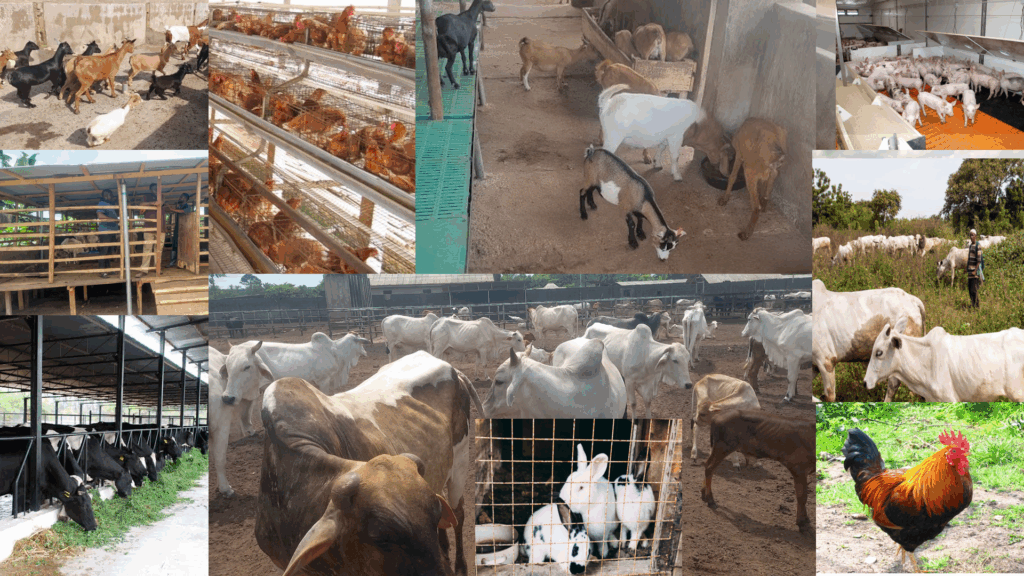In recent years, the cost of livestock feeds has skyrocketed across Nigeria and the rest of Africa, leaving many farmers struggling to maintain profitability. However, feeding your animals a balanced diet is non-negotiable if you want healthy, productive livestock. This article explores how African farmers can continue to provide balanced diets for their livestock, despite rising feed prices, ensuring maximum productivity while keeping costs under control.
The Importance of Balanced Diets in Livestock Farming
Livestock animals require a well-balanced diet that meets their specific nutritional needs. A balanced diet consists of the right proportions of energy, protein, vitamins, and minerals. Animals fed on poor diets may suffer from poor growth, reduced reproductive performance, lower immunity, and poor-quality meat or milk production. For layers, it also affects egg production and quality. Proper nutrition ensures healthier animals, which translates to higher productivity, better quality of produce, and greater profitability.
But how do you maintain this balance without breaking the bank?
1. Utilizing Locally Available Feed Ingredients
One way to reduce costs while maintaining a balanced diet for your animals is by sourcing locally available feed ingredients. Instead of relying on commercial feeds, which are often expensive, consider alternatives like maize, soybean meal, and cassava peels, which can provide necessary carbohydrates and protein. In Nigeria and many parts of Africa, agricultural by-products such as rice bran and groundnut cake are readily available and can be incorporated into livestock feed.
For poultry farmers, incorporating insects like Black Soldier Fly larvae as a source of protein is becoming popular due to its affordability and nutritional value. This approach not only reduces feed costs but also promotes sustainability.
2. Optimizing Forage-Based Diets for Ruminants
Ruminants such as cattle, sheep, and goats can thrive on forage-based diets. High-quality forages like Napier grass, alfalfa, and legumes can provide much of the required protein and energy for these animals. You can also improve the nutritional quality of forages through silage and haymaking techniques to ensure feed availability year-round.
Supplementing forage with minerals, particularly salt licks and calcium supplements, is essential to prevent deficiencies. By focusing on high-quality forage and minimal supplementation, you can significantly reduce feeding costs while maintaining animal health.
3. Home-Made Feed Formulations
Creating your own feed mix at home is another cost-saving measure that can ensure your livestock gets a balanced diet. You can combine locally available ingredients in the right proportions based on your livestock’s nutritional needs. Several feed formulation guides are available online, allowing you to calculate how much protein, energy, and minerals each mix contains.
For example, poultry farmers can make grower or layers mash by combining maize (as a source of energy), soybean meal or groundnut cake (for protein), and bone meal (for calcium). This method enables you to control the quality and cost of feed, ensuring your livestock receives optimal nutrition.
4. Exploring Alternative Protein Sources
With the rising cost of soybean meal and fish meal, which are common protein sources, many farmers are turning to alternatives such as Black Soldier Fly larvae, earthworms, and moringa leaves. These sources provide high-quality protein at a fraction of the cost of conventional ingredients.
Black Soldier Fly larvae, in particular, have gained traction in Nigeria and other African countries for their ability to convert organic waste into protein-rich feed. These larvae contain up to 45% protein and are easy to farm, making them a highly sustainable and affordable option for poultry, fish, and even pigs.
5. Reducing Feed Wastage
Often, the issue is not just the high cost of feed but also how much of it is wasted. Implementing better feeding practices can reduce wastage significantly. Invest in proper feeding equipment to avoid feed spillage, and feed your animals in quantities that meet their daily requirements without overfeeding.
For poultry farmers, using well-designed feeders and avoiding excess feed in the troughs can reduce wastage by up to 20%. Similarly, for cattle and goats, providing feed in troughs that minimize spillage can help save costs. Reducing waste also means more feed is available over time, reducing your overall feed expenses.
Conclusion: Smart Feeding for Maximum Productivity
Feeding livestock animals on a balanced diet is crucial, even in the face of high feed costs. By exploring locally available feed ingredients, optimizing forage for ruminants, formulating homemade feeds, using alternative protein sources, and reducing wastage, farmers can continue to provide their animals with the nutrition they need without breaking the bank.
To remain competitive and profitable, African farmers must adopt these cost-saving strategies while ensuring the nutritional balance of their livestock feed. As feed prices continue to rise, innovation and smarter feeding practices will be essential for sustaining livestock farming across Nigeria and the rest of Africa.
By following these tips, you not only improve your farm’s profitability but also contribute to the overall sustainability of the livestock farming industry.
Ready to Feed Smarter?
To learn more about sustainable feeding strategies and get expert insights on improving your livestock farming practices, subscribe to our newsletter at AgribusinessSpace.com. Stay informed and empowered to feed your livestock on a balanced diet—without overspending.


